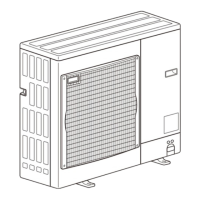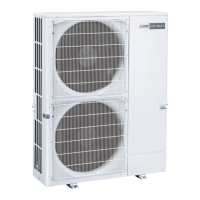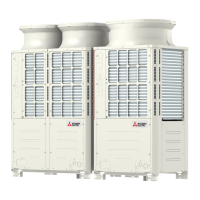
Do you have a question about the Mitsubishi PUZ-A18NHA6 and is the answer not in the manual?
| Cooling Capacity | 17, 100 BTU/h |
|---|---|
| Heating Capacity | 19, 500 BTU/h |
| Refrigerant | R410A |
| Indoor Unit Dimensions (W x H x D) | Not specified in the provided data |
| Outdoor Unit Dimensions (W x H x D) | 37-13/32 x 33-7/16 x 13 inches |
| Phase | 1 |
| Outdoor Unit Noise Level | 50 dB(A) |
| Weight (Indoor Unit) | 9 kg |
| Voltage (V) | 220-240 V |
| Indoor Unit Noise Level | 19-37 dB(A) |
| Indoor Unit Weight | 9 kg |
Lists indoor unit models and their service references.
Essential safety rules before and during maintenance operations.
Specific safety measures for handling R410A refrigerant.
Guidelines for safe and effective refrigerant piping work.
Describes the pre-charged refrigerant system for simplified installation.
Refrigerant charge amounts based on piping length for R410A.
Technical specifications for the unit's compressors.
Noise level data presented in graphical format.
Operational data under standard conditions.
Recommended clearances around the outdoor unit for proper operation.
Instructions for securing the unit with foundation bolts.
Specifies the direction for piping and wiring connections.
Minimum required space for installation around the outdoor unit.
Details on knockout holes for piping and wiring.
Wiring specs for units powered from the outdoor unit.
Wiring specs for separate indoor/outdoor unit power supplies.
Specifications for connecting cables between units.
Procedure for collecting refrigerant before servicing.
Method for testing refrigerant piping for leaks.
Steps for starting and finishing a test run.
Summary of troubleshooting actions based on recurring issues.
Pre-test run checks for troubleshooting.
Procedure for performing a test run using the remote controller.
Steps to view and delete error history from the system.
Guide for performing self-diagnosis.
Steps for initiating and interpreting self-diagnosis.
Procedure to check the remote controller's function.
Table of abnormalities, detection methods, and actions.
Troubleshooting guide for specific operational problems.
Common customer inquiries and troubleshooting responses.
Methods for checking common components.
Procedure for checking the outdoor controller circuit board.
Procedure for checking the noise filter circuit board.
Procedure for checking the power circuit board.
Procedure for checking the ACTM (Active Filter Module).
Procedure for checking the DC fan motor and its circuit board.
Component testing procedures and resistance values.
How to check linear expansion valves for different models.
Procedures and considerations for emergency operation.
Steps to perform emergency operation.
Steps to release emergency operation.
Operation data parameters during emergency operation.
Diagrams indicating test points for diagnostics.
Explains the function of switches, connectors, and jumpers.
Explains the functions of DIP switches and push switches.
Lists connector functions and their actions.
Maintenance data display and operation.
Details on smooth maintenance function for specific models.
How to navigate the remote controller menus.
Guide for interpreting operation conditions.
Initial settings for refrigerant leak detection.
Initial settings for refrigerant leak detection function.
Setting unit functions using the remote controller.
Lists functions available based on unit settings.
Lists functions available based on unit number.
How to select functions using the IR remote controller (Type C).
Details on function selection via remote controller.
Function selection procedures for specific remote controller models.
Procedure to monitor operation data.
Monitoring operation data for specific models.
List of request codes for data monitoring.
Detailed breakdown of request codes and their meanings.
Steps to remove top, service, front, and back panels.
Steps to remove the fan motor.
Steps to remove the electrical parts box.
Steps to remove specific thermistors.
Steps to remove the ambient thermistor.
Steps to remove liquid, comp. surface, and suction thermistors.
Steps to remove 4-way valve and LEV coils.
Steps to remove the 4-way valve.
Steps to remove the linear expansion valve.
Steps to remove the high pressure switch.
Steps to remove the reactor (ACL).
Steps to remove the compressor.
Steps to remove the accumulator.












